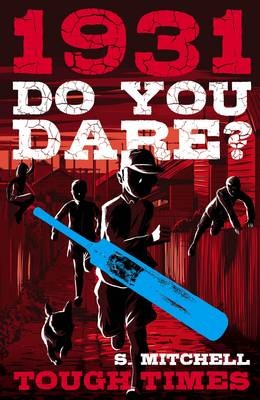Tough times: 1931: do you dare? by S. Mitchell

Do you dare? series. Puffin, 2014. ISBN 9780143308010.
1931 is a scramble through the mean streets of Melbourne's Fitzroy
as seen through the eyes of Max, aged about eleven. It is two years
into the Great Depression and unemployment is hitting Australia's
working-class families hard. When the book opens, Max's father is
still in work as a boot maker, although on reduced hours of two or
three days a week. With three children and the family pet, Fungus
('a constant irritation underfoot') to feed, and the mortgage to
pay, money is tight. Tom's love for his parents and siblings,
especially his four year old brother Petey, are a highlight of the
book. Tom's best friends from the Daredevils gang are Samson, whose
Dad died in the Spanish Flu outbreak and who is really poor, and
Frank, one of six children at a time when families were much larger
than they are today. The book appears to be written to engage boys
in reading and in history and will probably succeed at both,
especially with a vein of backyard 'dunny' humour and bare bums
(Fungus bites the seat out of the pants of Razor, the local hoodlum)
to sustain them. Girls may find it harder to relate to the
adventures, though the only female gang member, Joan, is a
thoroughly modern miss and the most daring devil of them all.
The figure who underpins the second part of the book is 'Mac', a
benevolent, white-suited gentleman who intervenes on Tom's behalf
just as it seems inevitable that his family must be torn apart. Mac
is 'Australia's Willy Wonka' - in real life, Sir MacPherson
Robertson, founder of Robertson's chocolate factory. In his early
life, MacPherson Robertson experienced greater privation than any of
the characters in the book and in later life he was a genuine
philanthropist. Students can extend their learning to
the life and legacy of this great Australian. South Australian
children can compare his efforts to counter the worst aspects of the
Depression with Sir Edward Hayward's decision in 1933 to initiate
the Christmas Pageant to raise the spirits of the people of
Adelaide. Other Australian 'icons' such as Phar Lap and six-o-clock
closing also provide opportunities to explore the social conventions
of the era.
South Australian teachers may be familiar with Max Colwell's book
Half Days and Patched Pants and play of the same name. Several
scenes in Tough times: 1931: do you dare? would also be very suitable to act out.
Even better, in keeping with the era, students could record and
present the scenes as a weekly radio show.
I would recommend Tough times: 1931: do you dare? to teachers wanting a springboard
into important local and global changes in our society that occurred
within the memory of older family members of the students of today.
Francine Smith